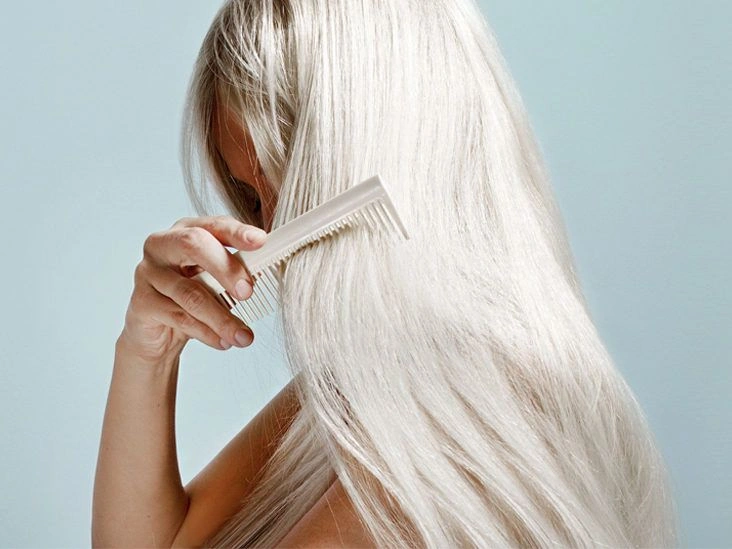Keratin treatments smooth the hair cuticle, creating a glossier finish. They can also speed up drying time. However, they tend to be costly and sometimes include ingredients that may pose health concerns.
Often called a Brazilian blowout or Brazilian keratin treatment, a keratin service is a chemical process typically performed in a salon that can leave hair appearing straighter for up to six months.
That said, these treatments may raise health concerns — including possible links to certain cancers — because of exposure to particular chemicals used in the formulas.
If you’re debating whether a keratin treatment is right for you, consider the advantages and drawbacks outlined below.

Possible advantages of keratin treatments
Keratin is a protein the body produces naturally; it is the primary component of hair and nails.
The keratin used in treatments may come from sources like wool, feathers, or horns. While some shampoos and conditioners contain keratin, the most noticeable improvement usually comes from a professional salon treatment.
Benefits of a professional keratin service or a home treatment can include:
Semi-permanent straightening
A keratin treatment can keep hair looking straighter for as long as six months.
Sleek, shiny hair
It delivers an intense glossy sheen and helps reduce frizz.
Keratin smooths the overlapping cells that form hair strands, making hair easier to manage and less frizzy. This leads to hair that dries with minimal frizz and appears glossy and healthy.
Keratin can also temporarily bond split ends together, reducing their appearance.
Certain formulations can soften curls, giving them a smoother look.
Fuller-looking hair
Replenishing keratin in hair may give it a fuller, thicker appearance.
Durable results
With careful upkeep—such as washing hair only 2 to 3 times weekly—a keratin treatment can persist for up to six months.
More manageable hair
Keratin treatments make hair simpler to style, particularly if it’s prone to heavy frizz.
If you frequently use heat tools, you may find your hair dries far quicker after a keratin treatment. Some people report cutting their drying time by more than half.
Your hair might also become stronger and healthier overall because you can rely more on air-drying, reducing heat-related damage.
Perceived hair growth
Keratin can strengthen strands and reduce breakage, which can make hair appear to grow faster since the ends are less prone to splitting off.
Possible risks of keratin treatments
Keratin hair treatments can carry health risks.
Formaldehyde and formaldehyde-releasing ingredients
Many (though not all) keratin formulas include formaldehyde, which can be hazardous when inhaled. Exposure may cause symptoms such as:
- headaches
- dizziness
- eye irritation
- sore throat
- coughing or wheezing
- chest discomfort
- nausea and vomiting
- skin rash
Formaldehyde is the component that helps hair appear straighter.
Regulatory guidance indicates this chemical may be listed under names like:
- formaldehyde
- formalin
- methylene glycol
Certain hazardous ingredients can release formaldehyde gas when exposed to heat.
One report described a 13-year-old girl who suffered severe kidney damage after exposure to formaldehyde in a product marketed as formaldehyde-free.
Health authorities advise checking ingredient lists and discussing salon safety procedures with your stylist to limit formaldehyde exposure. They have issued warnings to brands whose products contained unsafe levels of formaldehyde or failed to disclose its presence.
Potential cancer links
Research has associated chemical straightening products with an increased risk of breast cancer. In one study, women who used straighteners every 5 to 8 weeks or more frequently had a 31% higher risk of breast cancer.
Other studies suggest a connection between chemical straighteners and ovarian cancer, and researchers observed higher uterine cancer risk in women who used chemical straighteners more than four times per year.
Additional research links chemical straighteners to uterine cancer, noting an 80% higher adjusted risk among women who used a chemical straightening product within the previous 12 months.
Expense
Individual treatments typically cost between $300 and $800, plus tip. There are cheaper at-home options, but their effects usually do not last as long.
Maintenance challenges
Needing to wash hair less often and avoiding swimming can be inconvenient for some people.
- Water type matters: Swimming in chlorinated or salt water (pools or the ocean) can shorten the lifespan of a keratin treatment. You’ll also want to use shampoos and conditioners free of sodium chloride and sulfates, as these ingredients can strip the treatment.
- Delay washing: You must wait 3 to 4 days after a keratin treatment before getting your hair wet, so if you dislike skipping wash days this may not suit you. Some people report a lingering musty odor even after washing.
- Not for everyone: Keratin treatments are not recommended for pregnant people.
Frequently asked questions
Is a keratin treatment good for your hair?
Keratin treatments can benefit hair by reducing frizz, smoothing strands, and adding shine.
What is a keratin treatment, and how long does it last?
A keratin treatment is a chemical process that makes hair smoother and easier to manage. Results can last up to six months.
What are the pros and cons of keratin?
Keratin treatments can leave hair smooth and glossy while reducing frizz and speeding drying time. However, some of the chemicals used may pose health risks, including potential links to breast, ovarian, and uterine cancers.
The takeaway
Keratin treatments can make coarse, frizzy hair easier to handle and can shorten drying time.
They are costly, and many formulas contain formaldehyde, which can be harmful if inhaled. If you choose to proceed, ensure the procedure is done in a well-ventilated setting or select a formula that does not contain formaldehyde.


















Leave a Reply
You must be logged in to post a comment.